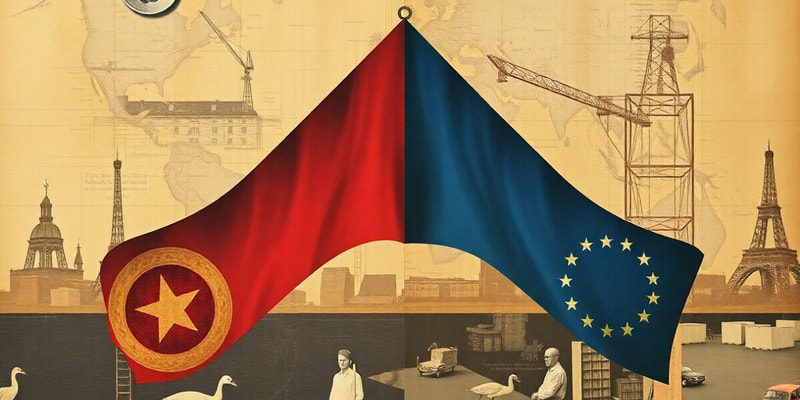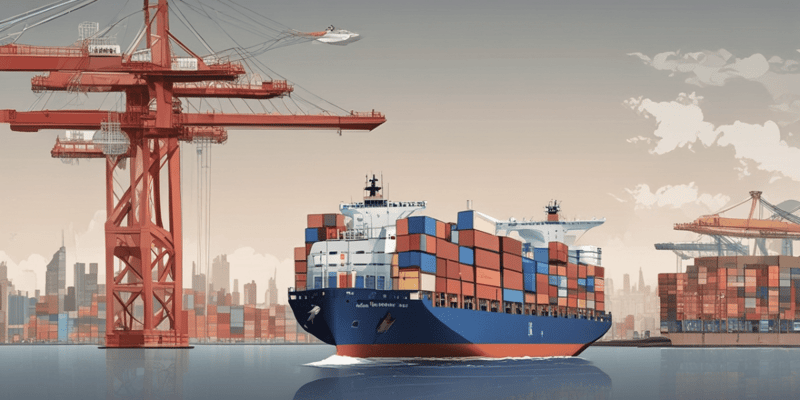Podcast Beta
Questions and Answers
What is the primary objective of Regional Trade Agreements (RTAs)?
Which of the following best describes bilateral agreements?
As of February 1st, 2021, how many Regional Trade Agreements were recorded?
What is NOT an example of what Regional Trade Agreements may encourage?
Signup and view all the answers
What distinguishes plurilateral agreements from bilateral agreements?
Signup and view all the answers
What defines a bilateral agreement?
Signup and view all the answers
Which of the following is an example of a multilateral agreement?
Signup and view all the answers
What is the main purpose of the Generalized System of Preference (GSP)?
Signup and view all the answers
How do multilateral agreements primarily operate?
Signup and view all the answers
What is a key distinguishing feature of bilateral agreements compared to multilateral agreements?
Signup and view all the answers
What defines a trading bloc?
Signup and view all the answers
Which of the following is an example of a trading bloc?
Signup and view all the answers
What is the main purpose of regional preferential trade agreements?
Signup and view all the answers
Which statement accurately describes free trade?
Signup and view all the answers
How does the Arab League function in the context of trade?
Signup and view all the answers
What is the primary goal of a free trade area?
Signup and view all the answers
Which of the following correctly describes a customs union?
Signup and view all the answers
Which of the following is an example of a free trade area?
Signup and view all the answers
What distinguishes a customs union from a free trade area?
Signup and view all the answers
Which statement is false regarding free trade areas?
Signup and view all the answers
What is a defining characteristic of a common market?
Signup and view all the answers
Which of the following regions is an example of a common market?
Signup and view all the answers
What is meant by a 'single currency' in the context of an economic and monetary union?
Signup and view all the answers
How does a common market contribute to economic integration?
Signup and view all the answers
Which of the following is NOT typically a feature of a common market?
Signup and view all the answers
What is one of the primary responsibilities of the World Trade Organization?
Signup and view all the answers
Which aspect of the WTO's structure supports its decision-making process?
Signup and view all the answers
How does the WTO engage with developing nations?
Signup and view all the answers
What is one of the main forums hosted by the WTO?
Signup and view all the answers
What key goal of the WTO contributes to overall trade stability?
Signup and view all the answers
What significant milestone occurred as a result of the Uruguay Round in 1995?
Signup and view all the answers
Which of the following highlights a limitation of GATT by the 1980s?
Signup and view all the answers
How many committees does the GATT council for trade in goods comprise?
Signup and view all the answers
What was one of the outcomes of the Uruguay Round regarding trade restrictions?
Signup and view all the answers
What was a reason for GATT losing its relevance by the 1980s?
Signup and view all the answers
What is the purpose of binding commitments in the WTO agreements?
Signup and view all the answers
Which of the following agreements focuses on the quality and safety of agricultural products?
Signup and view all the answers
Which type of agreements involve several countries with shared interests but do not require all WTO members to participate?
Signup and view all the answers
What benefit do least developed countries gain from developed countries under WTO agreements?
Signup and view all the answers
What is the focus of the Agreement on Trade-Related Investment Measures?
Signup and view all the answers
What percentage of export restrictions had been replaced by October 2021?
Signup and view all the answers
What was a significant topic of controversy at the Doha Round discussions?
Signup and view all the answers
What is the Most Favoured Nation (MFN) principle in the WTO?
Signup and view all the answers
When was the G20 founded?
Signup and view all the answers
Which of the following agreements includes the National Treatment principle?
Signup and view all the answers
During which period did India hold the Presidency of the G20?
Signup and view all the answers
Which of the following is NOT a key aspect discussed regarding measures after COVID-19?
Signup and view all the answers
How many member countries does the WTO currently have?
Signup and view all the answers
What does National Treatment ensure in relation to foreign goods?
Signup and view all the answers
What percentage of world trade does the WTO account for?
Signup and view all the answers
Study Notes
Regional Trade Agreements (RTAs)
- Regional Trade Agreements (RTAs) are groups of countries formed to reduce trade barriers between members. As of 2021, there were 339 RTAs.
- Bilateral Agreements are agreements between two countries, two blocs, or a bloc and a country.
- Plurilateral Agreements involve multiple countries.
- Examples of RTA objectives include encouraging GSP (Generalized System of Preferences), reducing duties, and other trade policies.
Types of Regional Trade Agreements (RTAs)
-
Bilateral Agreements: Agreements that set rules of trade between two countries, two blocs, or a bloc and a country.
- Example: ASEAN-India free trade area
-
Multilateral Agreements: Agreements that set rules of trade between many countries or blocs.
- Example: WTO (World Trade Organisation), where one country may offer trade incentives to another country's exports.
- Generalized system of preference (GSP): Promotes economic development by eliminating duties on various products from developing nations.
Trading Blocs
-
Trading Bloc: A group of countries with a free trade agreement among themselves and a common external tariff for trade with other countries.
- Examples:
- Arab League (AL)
- European Free Trade Association (EFTA)
- Examples:
-
Regional Preferential Trade Agreements: Agreement among a group of countries to reduce trade barriers on a preferential basis for members.
- Example: GSTP
-
Free Trade: Eliminating trade barriers among member countries.
- Example: ASEAN, India
Free Trade Area
- A group of countries that have eliminated trade barriers among themselves to enhance the exchange of goods.
- Example: ASEAN
Customs Union
- Countries with eliminated trade barriers amongst themselves and a common external tariff on trade with other countries.
Common Market
- A customs union that extends to the free flow of output and factors of production by reducing or eliminating internal tariffs and creating common external tariffs.
- Example:
- EU
- ASEAN
- Example:
Economic and Monetary Union
- A common market that provides for free transit of goods and services through borders, including a single currency.
- Example: EU
Uruguay Round
- Brought the largest reform to the world's trading system.
- Established 15 groups to limit restrictions.
- Began in Punta del Este (Uruguay), September 1986, and ended December 1993.
- Signed by most countries on April 15, 1994, and went into effect July 1, 1995, marking the birth of the WTO.
- Involved 123 participating countries.
GATT (General Agreement on Tariffs and Trade)
- Covers international trade on goods.
- Led by the Council for Trade in Goods (Goods Council).
- Consists of 10 committees, each with all member countries.
- Lost relevance in the 1980s due to:
- Lack of coverage for intellectual property rights and trade in services.
- Ambiguities in the multilateral system.
- Rising world merchandise trade surpassing GATT's scope.
- Unsuccessful efforts to liberalize agriculture.
- Trade surpluses in dispute settlement system.
- Not a treaty.
World Trade Organization (WTO)
-
Key objectives:
- Establish and enforce rules for international trade.
- Provide a forum for trade negotiations.
- Resolve trade disputes.
- Increase transparency in trade.
- Integrate developing nations into global economic management.
- Aid developing nations.
-
Structure:
- Secretariat in Geneva.
- Three-tiered decision-making system:
- Top
- Middle
- Lower
-
Guided principles:
- Most Favoured Nation (MFN): Treating all member countries equally.
- National Treatment: Treating foreign and local products equally.
-
National Treatment in WTO Agreements
- Found in:
- Article 3 of GATT: General Agreement on Tariffs and Trade
- Article 17 of GATS: General Agreement on Trade in Services
- Article 3 of TRIPS: Agreement on Trade-Related Aspects of Intellectual Property Rights
- Found in:
WTO Agreements
-
Predictability:
- Countries bind their commitments to open markets for goods and services, promoting clear and transparent rules.
-
Fair Competition:
- WTO encourages fair competition in agriculture, intellectual property, and services.
-
Development and Economic Reform:
- Developed countries allow duty-free and quota-free imports for almost all products from least developed countries, specifically in Africa.
-
Specific Agreements:
- Agreement on Agriculture
- Agreement on Application of Sanitary and Phytosanitary Measures
- Agreement on Textiles and Clothing (replaced MFA)
- Agreement on Technical Barriers to Trade (TBT)
- Agreement on Trade-Related Investment Measures
- Agreement relating to Anti-Dumping
- Customs Valuation Agreement
- Agreement relating to Pre-shipment Inspection (PSI)
- Agreement on Rules of Origin
- Agreement on Import Licensing Procedures
- Agreement on Subsidies and Countervailing Measures
-
GATS and TRIPS:
- General Agreement on Trade in Services (GATS):
- Trade-Related Aspects of Intellectual Property Rights (TRIPS):
-
Trade Policy Review Mechanism (TRAM):
- Plurilateral Agreements: Involve several countries with common interests, but not all WTO members.
DOHA ROUND
- Date: November 2001
- Key Aspects:
- Trade-related measures implemented after COVID-19.
- Many measures were "trade facilitating."
- By October 2021, approximately 71% of export restrictions were replaced.
- Most controversial topic: agricultural trade.
- G20:
- Founded in 1999, following the Asian financial crisis.
- Premier forum for international economic cooperation.
- India held the Presidency from December 1, 2022, to November 30, 2023.
- Other Points:
- Measures focused on initial implementation.
- Discussions on agricultural trade negotiations.
- Issues impacting the agricultural sector were addressed.
Studying That Suits You
Use AI to generate personalized quizzes and flashcards to suit your learning preferences.
Description
This quiz assesses your understanding of Regional Trade Agreements (RTAs), including bilateral and multilateral agreements. Learn about their objectives, benefits, and examples, such as the ASEAN-India free trade area and the WTO. Test your knowledge on the dynamics of international trade agreements.




